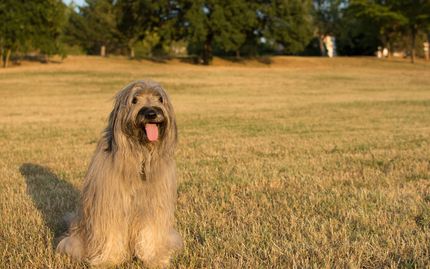Facts & Origin
Origin and history of the St. Bernard
The St. Bernard dog is also known as the St. Bernard. Its origin is in the Swiss Alps. He is the national dog of Switzerland.
On the "Great St. Bernard", a mountain pass in the Valais Alps, Augustinian monks founded a hospice for travelers called St. Bernard, which provided safe overnight accommodation and food. From about the 17th century, they used ancestors of today's mountain dogs (large farm dogs of the area) as transport, rescue and guard dogs. In the monastery's own breeding, the former farm dogs developed into the St. Bernards as we know them today.
The existence ofsuch dogs is documentedpictorially since 1695 and in writing in a note of the hospice in 1707. They were called "Barryhüng", bear dogs, and weighed a maximum of 50 kg. Because of their agility, endurance and excellent tracking ability they became famous avalanche dogs. The most famous representative of this breed in this area is "Barry I". However, it is unclear whether he actually existed. This Saint Bernard is said to have saved the lives of 40 people who were buried or buried by avalanches.
Starting in the 20th century, they became popular family dogs. They were bred for size and lost their agility, replacing their role as rescue dogs with other dog breeds. Because of their build and wariness of strangers, St. Bernards are occasionally kept as guard dogs.
Suitability and attitude
Nowadays, the St. Bernard is mostly kept as a yard dog, guard dog, and companion dog. Despite its appearance, it is a gentle and calm family dog that gets along well with children. They are not suitable as apartment or city dogs, but need consistent training and a high level of loving care.
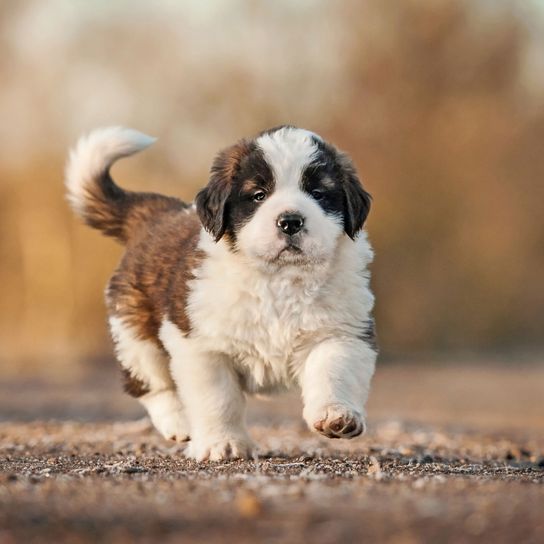
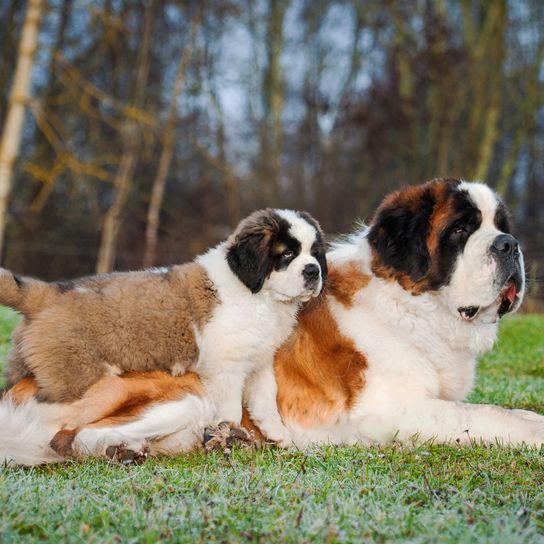

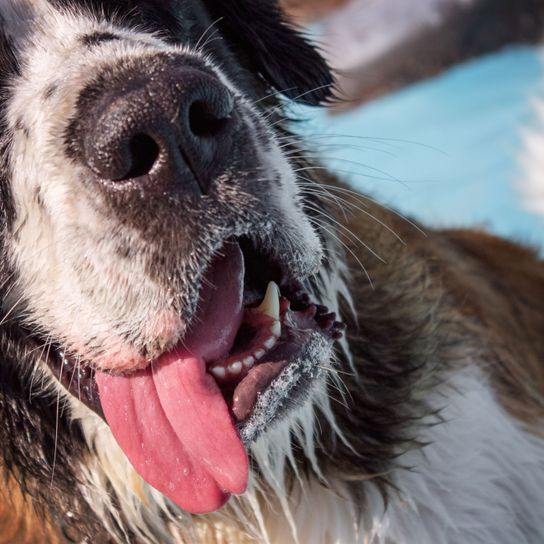
| Alternate Name | St. Bernard dog |
| Origin | Switzerland |
| Life expectancy | 8 - 10 years |
| Care requirements | high-maintenance |
| Activity level | average |
| FCI group | Molossian type |
| AKC group | Herding Group |
| KC group | Pastoral Group |
Saint Bernard mixes
Attitude, character and temperament of the breed
Typical character traits of the St. Bernard
The positive characteristics of the St. Bernard include
- Gentleness
- Attachment to its owners
- Intelligence
- Need for balance
- Loyalty
Only in exceptional cases St. Bernard reacts with aggressiveness. Together with their good-natured character they are suitable as playmates for children. Ball games are one of their favorite activities. However, care should be taken that small children do not accidentally end up under the dog's massive body when playing together.
St. Bernards need a lot of exercise because of their size, but they love long, leisurely walks. In winter, they love to play in the snow, well protected by their thick coats. However, these sensitive giants are occasionally prone to stubbornness and therefore need loving and consistent training.
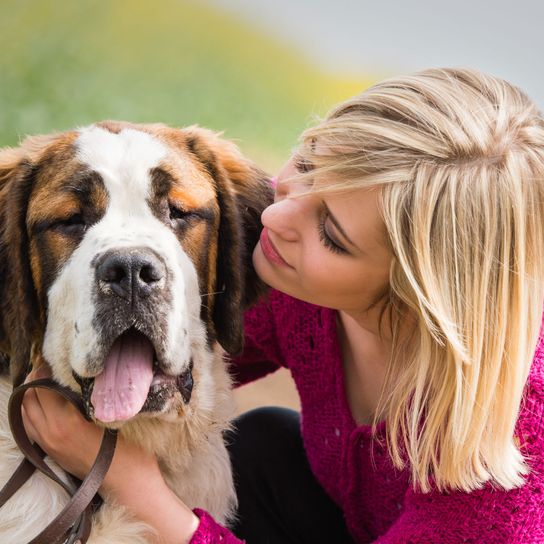

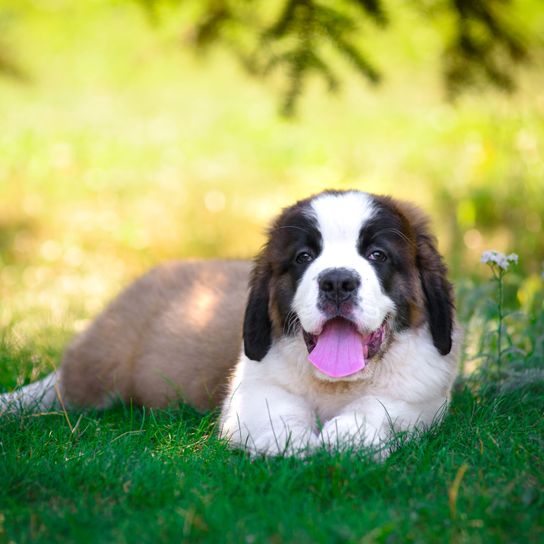

St. Bernard health
As a very large breed, the St. Bernard is at risk from a wide range of possible diseases. As a result, St. Bernards have a low life expectancy of about 9 years. Only one in five St. Bernards reach an age of over 10 years. Among these diseases are:
- Hip dysplasia
- Bone cancer
- Gastric torsion
- Hanging limbs
Care and health maintenance
The St. Bernard's eyes, ears and claws should be checked and cared for regularly. Diseases of the eyes and skin as well as tartar are typical, but these can be well controlled with timely intervention. When feeding, attention should be paid to a balanced diet. Optimal is a combination of meat and vegetables with many vitamins and minerals.
St. Bernards also tend to overeat and therefore put on weight easily. In addition, feeding pure dry food in combination with the extra water needed can increase the risk of gastric distention. A regular rest period after eating should definitely be scheduled.
St. Bernard breeding and purchase
When breeding, care should be taken to breed only with parents whose pedigree is known in order to have healthy puppies. Both parents must be tested for hip dysplasia to rule out disease in the offspring.
If you want to buy a Saint Bernard puppy from a good breeder, you have to calculate with costs between 950 and 1300 Euro. With the follow-up costs it is to be considered in addition that with large dog breeds everything is a little larger and more: The collar, the dog house and the food quantity.


Breed characteristics of the St. Bernard
The St. Bernard isclassified by the FCI as Group 2(Pinscher and Schnauzer, Molossoid, SwissMountain Dogs), Section 2.2 (Molossian, Mountain Dog type). No working test is required.
Size and weight
This dog breedprescribes a minimumheight for males of 70cm, for females of 65cm. At the same time, males should not exceed 90cm, bitches 80cm. However, the latter regulation is not too strict. Due to their size, they easily reach a weight of about 55-90kg; in some cases there are even numbers in the triple digits.
A specimen of this breed has aharmonious, reachingmovement with good good thrust from the hindquarters,while the back remains stable and remains stable and calm. The front-and hind feet are set straight forward.
The head
The head of the St. Bernard is massive, imposing and expressive. The strong, broad skull appearsslightly domed inprofileand whenviewedfrom thefront ; in affect (when excited), the base of the ears forms a straightlinewith the top of the head,whichgentlycurveslaterallyintothestrongly developed high cheek parts. The forehead, which has a distinctly developed furrow beginning at the base and running down the middle of the top of the head, seems to slopetoo steeply towardthe muzzle and is covered by skin that covers slight wrinkles converging toward the furrow above the eyes.Theoccipital protuberance isonlymoderately pronounced, but theupperocular archshould bestronglydeveloped and the stop distinct.
The muzzle
St. Bernards have a black,broad andangular nose with well opened nostrils. The muzzle itself is evenlybroad and has a straight nasal bridge with a slight groove. The edges of the lips are blackpigmented in a breed specimen, and thelips of the upper jawshould be strongly developed,tight and not toooverhanging,forming a wide curvetowards the nose .The corner of the mouth remains visible.
A complete scissoror pincer bite is typical of this breed , but a close fitting fore bite withoutloss of contact ofthe incisors is tolerated in breeding, as is the absence of PM1 (premolar 1) and M3.
The eyes & ears
The eyes of this breed are dark brown to hazel, moderatelydeep-set and with afriendlyexpression. Inbreeding, a natural,firmclosure of the eyelidsis desired. Nevertheless,averysmallkinkon the lower eyelid (withlittle visible conjunctiva) as well as on the upper ey elid is permissible. The eyelid margins should be completely pigmented .
Likewise medium sized ears areset high and wide.The auricles are strongly developed, the ear lobes supple, triangular with rounded tip. The posterior rim is slightly protruding, the anterior rim rests against the cheeks.
The rump
The strong neck ofsufficient length has a moderately developed throatlatchand dewlap. The upperprofile line gives animposing,harmonious, stately and well muscled overallappearance, leading over well defined withers into a broad, strong and firm back , the topline of which is straightand horizontal to the loin. The long croup is also only slightly sloping, but mergesharmoniouslyinto the tail set on.
The rib cage ismoderatelydeep with well sprung ribs, but not barrel shaped. Moreover, it does not reach lower than the elbows. The lower profile line is slightly tucked up towards the rear.
The tail
The tail of the Bernahrdinger is broad and strong at the base. It is long and heavy, the last tail vertebra shouldreach at least to the hock joint. At rest it is carried hanging straight down or slightly curved upward in the lower third, and higher when excited.
The limbs
The forelegs of this breed, seen from the front,are straight and parallel, butmoderatelybroad. The shoulder blades oblique, muscular and well fitting, are shorter than the upper arms and form to them a not too obtuse angle. The elbow is close-fitting and continues into a straight, strong-boned and dry-muscled forearm, the extension of which is the metacarpus. This is slightly angulated when viewed from the side.
The hindquarters should be moderatelyangulated and muscular in generaland parallel, but not tight, when viewedfrom behind. The strong thigh has a broad club, the stifle joint is well angulated and neither turned out nor in. The following lower leg is oblique and fairly long. The hock should be slightly angulated but firm and the hind pasternstraight and parallel when viewed from behind.
The paws are generally breite, with strong,closeeach otherlyingstrongly arched toes. Dewclawson the hind feet aretolerated,iftheythe movementdo not hinder the course of movement.
The coat
The St. Bernard comes in two varieties:
- Shorthaired (stockhaired): in which the outer coat is dense, smooth, close-lying as well as coarse, and the undercoat isabundant. Thehaunches are lightly fringed, and the tail is densely furnished with hair.
- Longhair: Longhair Bernhardines have medium length, straight topcoat with abundant undercoat. However, the face and ears are short haired and over the hips and croup the coat is usually somewhat wavy. The forelegs are feathered and typical are strongly hoofed haunchesand a bushy tail.
Basic color of this breed is alwayswhitewith smaller orlargerclear red plates (plate dogs) to continuousclear to dark red blanketsoverbackandflanks(coat dogs). A torn coat (blanket interspersed with white) is considered equivalent.Thereby brindle isReddish brownis permissible,brown-yellowbut onlytolerated.A dark dressingatheadisdesired, as well asApproachofsblack shades.
There are predefinedwhitemarkings on chest,paws,tip of tail, noseband, blaze and neck patch.Furthermore, the following markings are not mandatory but desirable: awhitecollarand a symmetricaldark mask.
| Fur length | medium |
| Fur | flat coated |
| Ear shape | - |
| Tail | fanned out |
| Anatomy | strong |
| Size ♀ | 65 - 80 cm |
| Weight ♀ | 64 - 120 kg |
| Size ♂ | 70 - 90 cm |
| Weight ♂ | 64 - 120 kg |
| Suitable For | - |
Colors


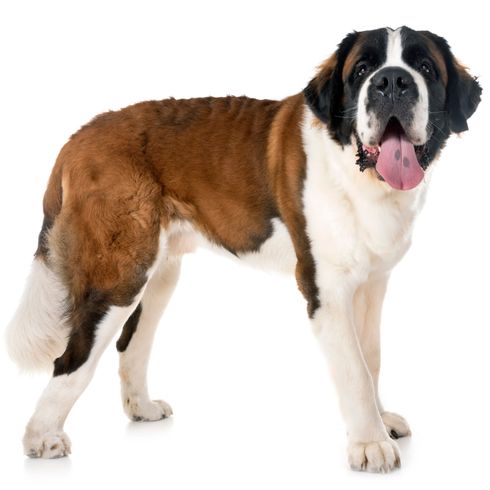
Known Diseases
Epilepsy
Definition: Dog has epilepsy if, for example, at least two epileptic seizures occur more than 24 hours apart.
Cancer
May be common in older dogs.
Skeletal disorders
IPA, FPC and OCD occur in dogs at four to five months of age during the most severe growth spurt.
FAQ
-
Can yes, should no. A St. Bernard is one of the largest dog breeds and accordingly needs space. If you have a large apartment and spend a lot of time with the dog outdoors, it can of course work. However, it is recommended to have a house with a garden to keep this large animal species-appropriate.
-
Yes, a Saint Bernard is an ideal guard dog.
-
A St. Bernard puppy costs about 1500 euros.
-
No, a Berhardine dog is not dangerous and is not considered a list dog.
-
The Saint Bernard is a large breed of dog that was originally bred as a lap dog and later as a rescue dog. The breed is characterized by its strength, endurance and friendliness.
-
St. Bernards usually reach a shoulder height of at least 71 cm for males and 66 cm for females, and a weight of 50-90 kg.
-
The coat of a Saint Bernard is long and dense and requires regular grooming to remain in good condition. It is important to brush the coat regularly to prevent and remove matting. It is also important to wash the coat as needed to remove dirt and odors.
-
St. Bernards are generally friendly and gentle dogs, but they require regular exercise and exercise as well as consistent training and socialization to improve their behavior and manners. Because they are a large breed, it can be difficult for beginners to manage and train them, but with the right preparation and support, they can be great family dogs.
-
It is important to train and socialize a St. Bernard early on to avoid undesirable behavior. Positive reinforcement is an effective method for training St. Bernards, and it is important to be consistent and patient to achieve the best possible results. It is also important to keep the St. Bernard busy and challenged on a regular basis to improve his physical and mental abilities.
























